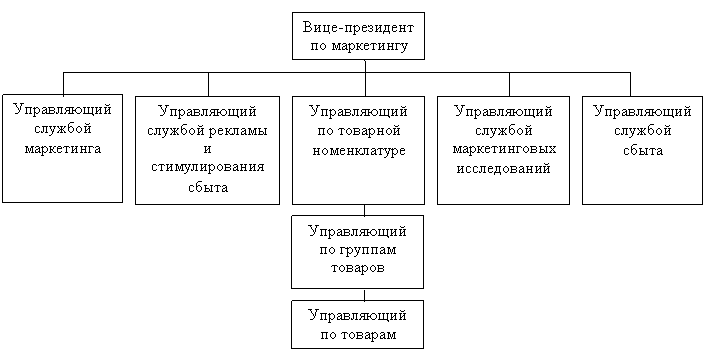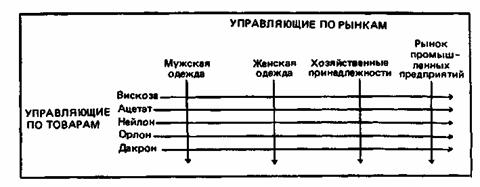home
 Marketing Marketing
 Principles of Marketing - Philip Kotler Principles of Marketing - Philip Kotler
|
Principles of Marketing - Philip Kotler
The system of organization of marketing service
The company should develop a structure of marketing department, which is able to take care of all the marketing work, including planning. If a company is very small, all of the marketing duties can be assigned to one person. He will be charged with and market research, and sales organization and advertising, service and service for customers, etc. This person may be called manager marketing service manager for marketing or marketing director. If the company is large, it usually has several experts in the field of marketing. Thus, in the state of "Helene Curtis" there are sellers, managing sales service, marketing, advertising specialists, researchers, controls the production of simple and branded goods, the control by market segment and employees of the service life for customers. Implementation of all marketing functions manages the marketing department.
SCHEME OF THE MARKETING DEPARTMENT.
Today, marketing departments can be organized on different bases. Each company creates a marketing department in such a way that it best contribute to achieving its marketing objectives.
Functional organization. The most common scheme is the functional organization of the marketing department. In this case, the marketing experts led by different types (functions) marketing activities. They are subject to vice president of marketing, who coordinates their work. In the circuit of Fig. 12 shows five such experts: manager marketing service manager service advertising and sales promotion, marketing service manager, service manager of market research and the control on new products. In addition to them, may be another service manager service for clients, managing marketing planning service and managed service product distribution.
The main advantage is the simplicity of the functional organization of the control. On the other hand, as the growth and product mix company markets this scheme increasingly loses its effectiveness. It is becoming increasingly difficult to develop specific plans for each individual market or product, as well as to coordinate the marketing activities of the company in, general.

Fig. 12. Functional organization
The organization on a geographical basis. The companies that sell all over the country, the subordination of merchants often takes the form of the organization on a geographical basis. In the circuit of Fig. 13 shows the one managing the national sales service, four regional control services sales, 24 Governors zonal marketing services, 192 district managers and sales 1920 sales agents. When organizing geographically salespeople can live within the territories they serve, getting to know their customers and operate efficiently with minimum cost of time and money on traveling.
Organization for commodity production. Companies with broad commodity nomenclature and / or a variety of branded goods use the organization on the commodity or commodity-branded production. Organization for commodity production does not replace functional organization, but is another management level. All commodity production led by Manager of the commodity nomenclature, which are subject to more control by groups of goods, which in turn are subject to control by product, each responsible for its production of a particular product (see. Fig. 14). Each control on the product independently develop their own production plans, monitors their implementation, monitor results, and reviewing these plans if necessary.

Fig. 13. Geographical Organization

Figure 14. On commodity production organization
Organization for commodity production is justified in cases where the products sold by the company are very different from each other and / or varieties of these products so much that when the functional marketing organization to manage all this nomenclature is no longer under force.
Organization on the basis of commodity production for the first time adopted in 1927, the company "Procter & Gamble". Her new soap "cameos" matter went on the market, and one of the young leaders - X. Neil McElroy, who later became president of the company, - instructed to concentrate on the finalization of this product and promoting its sale. The work was a success, and soon appeared in the company and other control on goods.
Since then, the organization has found the spread of commodity production in many companies, especially in the food industry, the manufacture of soaps, perfumes, cosmetics and chemical products. For example, a corporation "General Foods" put the organization on commodity production in his office "Post." Now there exist individual control by group of goods - products of cereal grains, animal feed and beverages. Within the product group of cereals have control for the production of nutritional cereals, sweetened cereal for kids, "Family" and flakes of different dishes from cereals. Managing the production of nutritious cereal, in turn, directs the work of the Governing trademark markam5.
The organization on commodity production has a number of advantages. Firstly, the product manager for coordinating the entire range of marketing this product. Secondly, managing by product specialists can quickly respond to specific emerging market issues. Third, not ignored also smaller, secondary by-value branded products, as the production of each of them manages their own manager. Fourth, the production of product management - an excellent school for young leaders, for this work they are involved in almost all areas of operations of the company.
However, these benefits are associated with costs. Firstly, the control system of commodity production leads to a number of conflicts and razocharovaniy6. Often managers by goods do not have sufficient rights for the effective performance of their duties. Secondly, becoming experts in all matters relating to their products, the control on goods are rarely experts in functional areas. Third, the control system of commodity production is often more costly than originally anticipated due to the increased cost of labor a greater number of employees.
Organization according to market principles. Many companies sell products to its range of different markets in nature. For example, the company "Smith-Corona" sells its electric typewriters in three markets - individual consumers, businesses and government agencies. The company "Yu US Steel "is selling his steel railway companies, construction industry and utilities industries and services. Using the company according to market principles, it is desirable in those cases where the different markets different buying habits and preferences of different brands.
Organization of the market principle is similar to the system of commodity production organization, shown in Fig. 14. Managing the market directs the activities of the several control for individual markets. Manager to work with the market responsible for developing long-term and annual plans of sales and other types of functional activities. The main advantage of this system lies in the fact that the company builds its work in relation to the needs of the consumers making up the specific market segments.
Many firms have already rebuild their structure on this principle. "Xerox" company refused from commercial activities on a geographical basis in favor of the principle of the sales industry. The company "Heinz" broke their marketing service in three departments: Department for servicing grocery-gastronomic trade, service department catering enterprises and service institutions department. Each department has its own group of experts on the market. For example, in the department of service institutions have experts to work with schools, colleges, hospitals and prisons.
Organization for commodity-market principles. Before firms selling lots of different products in many different markets, there is a problem: whether to use a system of organization for commodity production, which requires managers by goods knowledge very different from each other markets, or apply in their system of organization according to market principles, in which the Governing dealing with markets must be familiar with a variety of goods purchased in their markets. And the company can have both at home and control on goods, and control the markets, ie to apply the so-called matrix organization.
Box 5. Commodity-market system of the organization on the example of the company "DuPont"
The department of textile fiber company "DuPont" is a service control on goods and service managers on the markets.
Control by goods responsible for the planning of sales and profits from the sale of its fiber production. They concentrate mainly on short-term results of trading activities and the use of fibers. They should contact the managers on the market and ask each of them data on expected sales of its products on each market. On the other hand, the control on the market are responsible for the development of profitable markets for existing and potential fiber "DuPont." They produce a forward-looking assessment of market needs and care is not primarily about promoting the specific fibers, and the creation of a market for each appropriate to the needs of goods. Preparing a work plan on the market, they communicate with all control on the goods and receive from each of them the information about the planned prices and volumes of manufacture of various materials. The final sales forecasts made by market managers and managers for the goods, must give by adding the same general result.

However, such a system requires a costly organization and generates conflicts. Here are two examples of the many possible conflicts.
1. What should be the organization of sales force? Should the company "DuPont" (see. Box 5) have separate sales force for trade viscose, nylon and other fibers? Or it should be grouped by market sellers of men's clothing, women's clothing, and so on. Or maybe it is not worth to specialize your sales staff?
2. Who should set the price of a particular product in a particular market? In the example of "Dupont" should the production manager nylon having the final authority in determining the price of nylon in all markets? What happens if the manager to work with the men's clothing market will feel that nylon will not be successful in this market without some concessions on price?
Most managers believe that the introduction of individual posts is justified only in cases of the most important for the company's products and markets. But some did not bother no conflicts, no costs, and they are confident that the advantages of a matrix organization outweigh the associated costs?


Comments
Commenting, keep in mind that the content and the tone of your messages can hurt the feelings of real people, show respect and tolerance to his interlocutors, even if you do not share their opinion, your behavior in terms of freedom of speech and anonymity offered by the Internet, is changing not only virtual, but real world. All comments are hidden from the index, spam control.